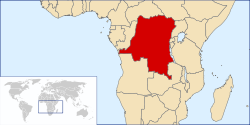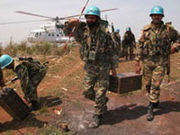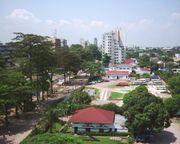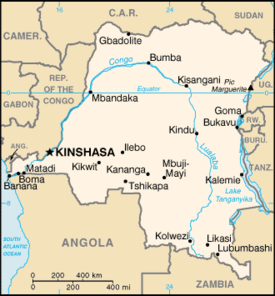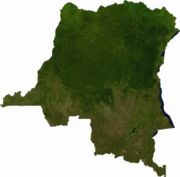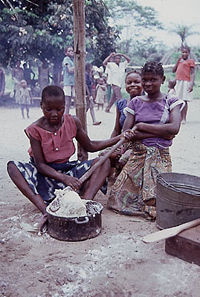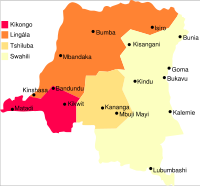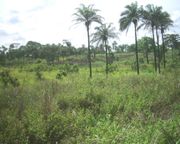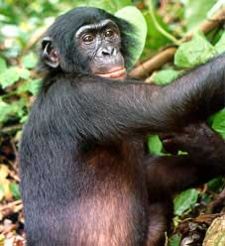Democratic Republic of the Congo
2008/9 Schools Wikipedia Selection. Related subjects: Africa; African Countries
| République démocratique du Congo Democratic Republic of the Congo
|
||||||
|---|---|---|---|---|---|---|
|
||||||
| Motto: Justice – Paix – Travail (French) "Justice – Peace – Work" |
||||||
| Anthem: Debout Congolais |
||||||
|
|
||||||
| Capital (and largest city) |
Kinshasaa |
|||||
| Official languages | French | |||||
| Recognised regional languages | Lingala, Kongo/ Kituba, Swahili, Tshiluba | |||||
| Demonym | Congolese | |||||
| Government | Semi-Presidential Republic | |||||
| - | President | Joseph Kabila | ||||
| - | Prime Minister | Antoine Gizenga | ||||
| Independence | ||||||
| - | from Belgium | June 30, 1960 | ||||
| Area | ||||||
| - | Total | 2,344,858 km² ( 12th) 905,351 sq mi |
||||
| - | Water (%) | 3.3 | ||||
| Population | ||||||
| - | 2007 estimate | 62,636,000 ( 21st) | ||||
| - | 1984 census | 29,916,800 | ||||
| - | Density | 25/km² ( 179th) 65/sq mi |
||||
| GDP ( PPP) | 2005 estimate | |||||
| - | Total | $46.491 billion1 ( 78th) | ||||
| - | Per capita | $774 ( 174th) | ||||
| GDP (nominal) | 2005 estimate | |||||
| - | Total | $7.094 billion ( 116th) | ||||
| - | Per capita | $119 ( 181th) | ||||
| HDI (2007) | ▲ 0.411 (low) ( 168th) | |||||
| Currency | Franc congolais ( CDF) |
|||||
| Time zone | WAT, CAT ( UTC+1 to +2) | |||||
| - | Summer ( DST) | not observed ( UTC+1 to +2) | ||||
| Internet TLD | .cd | |||||
| Calling code | +243 | |||||
| a Estimate is based on regression; other PPP figures are extrapolated from the latest International Comparison Programme benchmark estimates. | ||||||
The Democratic Republic of the Congo (French: République démocratique du Congo), also often referred to as DR Congo, DRC, RDC or formerly as Congo Free State, Belgian Congo, The Congo, Congo-Leopoldville, Congo-Kinshasa, and Zaire (or Zaïre in French), is the third largest country by area on the African continent. Though it is located in the Central African UN subregion, the nation is economically and regionally affiliated with Southern Africa as a member of the Southern African Development Community (SADC). It borders the Central African Republic and Sudan on the north, Uganda, Rwanda, and Burundi on the east, Zambia and Angola on the south, the Republic of the Congo on the west, and is separated from Tanzania by Lake Tanganyika on the east. The country enjoys access to the ocean through a forty-kilometre stretch of Atlantic coastline at Muanda and the roughly nine-kilometre wide mouth of the Congo river which opens into the Gulf of Guinea. The name "Congo" (meaning "hunter") is coined after the Bakongo ethnic group who live in the Congo river basin.
Formerly the Belgian colony of the Belgian Congo, the country's post-independence name was the Republic of the Congo until August 1, 1964, when its name was changed to Democratic Republic of the Congo (to distinguish it from the neighboring Republic of the Congo). On October 27, 1971, then- President Mobutu renamed the country Zaire, from a Portuguese mispronunciation of the Kikongo word nzere or nzadi, which translates to "the river that swallows all rivers." Following the First Congo War which led to the overthrow of Mobutu in 1997, the country was renamed Democratic Republic of the Congo. From 1998 to 2003, the country suffered greatly from the devastating Second Congo War (sometimes referred to as the African World War), the world's deadliest conflict since World War II. However, related fighting still continues in the east of the country.
History
Congolese pre-history
A wave of early peoples is identified in the Northern and North-Western parts of Central Africa during the second millennium BC. They were food producing (pearl millet), with some domestic stock, and developed a kind of arboriculture mainly based on the oil palm. Several centuries later, around 2,500 BC, bananas were known to some in south Cameroon.
From 3,500 BC to 2,000 BC, starting from a nucleus area in South Cameroon on both banks of the Sanaga River, the first Neolithic peopling of northern and western Central Africa can be followed south-eastwards and southwards. In D.R. Congo the first villages in the vicinity of Mbandaka and the Tumba Lake are known as the 'Imbonga Tradition', from around 2,600 BC. In Lower Congo, north of the Angolan border, it is the 'Ngovo Tradition' around 2,300 BC that shows the arrival of the Neolithic wave of advance.

In Kivu, across the country to the east, the ' Urewe Tradition' villages first show up around 2,600 BC. The few archaeological sites known in Congo are a western extension of the 'Urewe' Culture which is mainly known in Uganda, Rwanda, Burundi, and Western Kenya and Tanzania. From the start of this tradition, the people knew iron smelting, as is evidenced by several iron smelting furnaces excavated in Rwanda and Burundi.
The earliest evidence further to the west is known in Cameroon, and near to the small town of Bouar in Central Africa. Though an ongoing discussion will ultimately give us a better chronology for the start of iron production in Central Africa, the Cameroonian data places iron smelting north of the Equatorial Forest around 2,600 BC to 2,500 BC . This technology developed independently from the previous Neolithic expansion some 900 years later. As fieldwork done by a German team shows, the Congo river network was slowly settled by food-producing villagers going upstream in the forest. Work from a Spanish project in the Ituri area further east suggests villages reached there only around 800 BC.
The supposedly Bantu-speaking Neolithic, and then iron-producing, villagers added to and displaced the indigenous Pygmy populations (also known in the region as the "Bitwa" or "Twa") into secondary parts of the country. Subsequent migrations from the Darfur and Kordofan regions of Sudan into the north-east, as well as East Africans migrating into the eastern Congo added to the mix of ethnic groups. The Bantus imported a mixed economy made up of agriculture, small stock raising, fishing, fruit collecting, hunting and arboriculture before 3,500 BC; iron-working techniques, possibly from West Africa, are a much later addition. The villagers established the Bantu language family as the primary set of tongues for the Congolese.
| Historical nation-states of present-day Democratic Republic of the Congo |
|
Kingdom of Kongo (1395-1914) |
In the fifth century, a society began to develop in a region that initially encompassed only a 200 kilometer (125 mi) area along the banks of the Lualaba River in the modern day Katanga Province. This culture, known as the Upemba, would eventually evolve into the more significant Luba kingdom.
The Congo Free State (1877 – 1908)
European exploration and administration took place from the 1870s until the 1920s — first by Sir Henry Morton Stanley who undertook his explorations mainly under the sponsorship of King Leopold II of Belgium, who desired what was to become the Congo as a colony. In a succession of negotiations, Leopold, professing humanitarian objectives in his capacity as chairman of the Association Internationale Africaine, played one European rival against the other. The Congo territory was acquired formally by Leopold at the Conference of Berlin in 1885. He made the land his private property and named it the Congo Free State. Leopold's regime began undertaking various projects, such as the railway that ran from the coast to Leopoldville (now Kinshasa) which took years to complete. Nearly all these projects were aimed at increasing the capital Leopold and his associates could extract from the colony, leading to exploitation of Africans. In the Free State, the local population was brutalized in exchange for rubber, a growing market with the development of rubber tires. The selling of the rubber made a fortune for Leopold, who built several buildings in Brussels and Ostend to honour himself and his country. To enforce the rubber quotas, the Force Publique (FP) was called in. The FP was an army, but its aim was not to defend the country, but to terrorise the local population. The Force Publique made the practice of cutting off the limbs of the natives as a means of enforcing rubber quotas a matter of policy; this practice was widespread. During the period between 1885 and 1908, between five and 15 (the commonly accepted figure is about ten) million Congolese died as a consequence of exploitation and diseases. A government commission later concluded that the population of the Congo had been "reduced by half" during this brutal period.The actions of the Free State's administration sparked international protests led by E. D. Morel and British diplomat/Irish patriot Roger Casement, whose 1904 report on the Congo condemned the practice, as well as famous writers such as Mark Twain. Joseph Conrad's novella Heart of Darkness also takes place in Congo Free State. In 1908, the Belgian parliament, which was at first reluctant, bowed to international pressure (especially from Great Britain) by taking over the Free State from the king as a Belgian colony. From then on, it became the Belgian Congo, under the rule of the elected Belgian government.
The Belgian administration: Belgian Congo (1908 – 1960)
Conditions in the Congo improved following the Belgian government's takeover. Select Bantu languages were taught in primary schools, a rare occurrence in colonial education. Colonial doctors were to greatly reduce the spread of African trypanosomiasis, commonly known as sleeping sickness. The colonial administration implemented a variety of economic reforms that focused on the improvement of infrastructure: railways, ports, roads, mines, plantations and industrial areas. The Congolese people, however, lacked political power and faced legal discrimination. All colonial policies were decided in Brussels and Leopoldville. The Belgian Colony-secretary and Governor-general, neither of whom was elected by the Congolese people, wielded absolute power. Among the Congolese people, resistance against their undemocratic regime grew over time. In 1955, the Congolese upper class (the so-called "évolués"), many of whom had been educated in Europe, initiated a campaign to end the inequality.
During World War I, the Congolese Force Nationale successfully attacked, invaded and occupied German East Africa, which included the present-day Rwanda and Burundi. Belgium continued to administer these colonies under League of Nations mandates after the war, instituting racial policies that set the stage for the Rwandan genocide of 1994.
During World War II, the small Congolese army achieved several victories against the Italians in North Africa. The Belgian Congo, which was also rich in uranium deposits, supplied the uranium that was used by the United States to build the atomic weapons that were used in the bombings of Hiroshima and Nagasaki in August 1945.
Political crises (1960 – 1965)
In May 1960, the MNC party or Mouvement National Congolais, led by Patrice Lumumba, won the parliamentary elections, and Lumumba was appointed Prime Minister. Joseph Kasavubu, of the ABAKO (Alliance des Bakongo) party, was elected President by the parliament. Other parties that emerged include the Parti Solidaire Africain (or PSA, led by Antoine Gizenga) and the Parti National du Peuple (or PNP led by Albert Delvaux and Laurent Mbariko).
The Belgian Congo achieved independence on June 30, 1960 under the name "Republic of Congo" or "Republic of the Congo" ("République du Congo"). As the French colony of Middle Congo (Moyen Congo) also chose the name "Republic of Congo" upon receiving its independence, the two countries were more commonly known as "Congo-Léopoldville" and "Congo-Brazzaville", after their capital cities. In 1966, Joseph Mobutu changed the country's official name to "Democratic Republic of the Congo", and in 1971 it was changed again to "Republic of Zaïre".
Shortly after independence, the provinces of Katanga (with Moise Tshombe) and South Kasai engaged in secessionist struggles against the new leadership.
Subsequent events led to a crisis between President Kasavubu and Prime Minister Lumumba. On September 5, 1960, Kasavubu dismissed Lumumba from office. Lumumba declared Kasavubu's action "unconstitutional" and a crisis between the two leaders developed.
Lumumba had previously appointed Joseph Mobutu chief of staff of the new Congo army, Armee Nationale Congolaise (ANC). Taking advantage of the leadership crisis between Kasavubu and Lumumba, Mobutu garnered enough support within the army to create sentiment sufficient to inspire mutinous action. With financial support from the United States and Belgium, Mobutu made payments to his soldiers in order to generate their loyalty. The aversion of Western powers towards communism and leftist ideology in general influenced their decision to finance Mobutu's quest to maintain "order" in the new state by neutralizing Kasavubu and Lumumba in a coup by proxy.
On January 17, 1961, Katangan forces and Belgian paratroops, supported by foreign interests intent on copper and diamond mines in Katanga and South Kasai, kidnapped and executed Patrice Lumumba. Amidst widespread confusion and chaos, a temporary government led by technicians (College des Commissaires) with Evariste Kimba, and several short governments Joseph Ileo, Cyrille Adoula, Moise Tshombe took over in quick succession. See the book The Assassination of Lumumba by Ludo de Witte. The execution is known to have been witnessed by at least one CIA observer.
Zaire (1971 – 1997)
Following five years of extreme instability and civil unrest, Joseph-Désiré Mobutu, now Lieutenant General, overthrew Kasavubu in a 1965 coup. He had the support of the United States on account of his staunch opposition to Communism, which would presumably make him a roadblock to Communist schemes in Africa. It is also argued that the Western support for Mobutu was also related to his allowing businesses to export the many natural resources of Zaire without worrying about environmental, labour, or other regulations. A one-party system was established, and Mobutu declared himself head of state. He would periodically hold elections in which he was the only candidate.
Relative peace and stability was achieved; however, Mobutu's government was guilty of severe human rights violations, political repression, a cult of personality (every Congolese bank note displayed his image, his portrait was displayed in all public buildings, most businesses, and on billboards, and it was common for ordinary people to wear his likeness on their clothing), and excessive corruption. Corruption became so prevalent the term "le mal Zairois" or "Zairean Sickness" was coined, reportedly by Mobutu himself. As soon as 1984, he was said to have $4 billion (USD), an amount close to the country's national debt, deposited in a personal Swiss bank account. International aid, most often in the form of loans, enriched Mobutu while national infrastructure such as roads deteriorated to as little as one-fourth of what had existed in 1960. The term " kleptocracy" was in fact coined to describe Mobutu's embezzlement of government funds.
In a campaign to identify himself with African nationalism, starting on June 1, 1966, Mobutu renamed the nation's cities (Léopoldville became Kinshasa [the country was now Democratic Republic of The Congo – Kinshasa], Stanleyville became Kisangani, and Elisabethville became Lubumbashi). This renaming campaign was completed in the 1970s. In 1971, he renamed the country the Republic of Zaire, its fourth name change in 11 years and its sixth overall. The Congo River became the Zaire River. In 1972, Mobutu renamed himself Mobutu Sese Seko Kuku Ngbendu Wa Za Banga.
Following the collapse of the Soviet Union, U.S. relations with Kinshasa cooled, as Mobutu was no longer deemed necessary as a Cold War ally, and his opponents within Zaire stepped up demands for reform. This atmosphere contributed to Mobutu's declaring the Third Republic in 1990, whose constitution was supposed to pave the way for democratic reform. The reforms turned out to be largely cosmetic, and Mobutu's rule continued until conflict forced him to flee Zaire in 1997. The name of the nation was returned to the Democratic Republic of the Congo, as the name Zaire carried strong connections to the rule of Mobutu.
Conflict and transition (1994 – present)
Since 1994, the Congo has been wrought by ethnic strife and civil war, touched off by a massive inflow of refugees fleeing the Rwandan Genocide. The government of Mobutu Sese Seko was toppled by a rebellion led by Laurent-Désiré Kabila in May 1997; he changed the country's name back to Democratic Republic of The Congo-Kinshasa (the capital of Congo/Zaire). His former allies soon turned against him, however, and his regime was challenged by a Rwandan and Ugandan-backed rebellion in August 1998. Troops from Zimbabwe, Angola, Namibia, Chad, and Sudan intervened to support the new regime in Kinshasa. See Foreign relations of Congo and First Congo War.
A cease-fire was signed on July 10, 1999; nevertheless, fighting continued apace especially in the eastern part of the country, financed by revenues from the illegal extraction of minerals such as coltan, cassiterite and diamonds. Kabila was assassinated in January 2001 and his son Joseph Kabila was named head of state. The new president quickly began overtures to end the war and an accord was signed in South Africa in 2002. By late 2003, a fragile peace prevailed as the Transitional Government was formed. Kabila appointed four vice presidents, two of whom had been fighting to oust him until July 2003. Much of the east of the country remains insecure, primarily due to the Ituri conflict and the continued activity of the Democratic Forces for the Liberation of Rwanda in the Kivus.
This period of conflict has been the bloodiest in history since World War II. Almost 5 million people have died as a result of the fighting. The United Nations is concerned that 1000 people a day are still dying as a result of the conflict and described 2006 as a "make or break point" for the continuing humanitarian crisis.
On July 30, 2006, the Congo held its first multi-party elections since independence in 1960. After this Joseph Kabila took 45% of the votes and his main opponent Jean-Pierre Bemba took 20%. That was the origin of a two-day fight between the two factions from August 20, 2006 in the streets of the capital, Kinshasa. Sixteen people died before police and the UN mission, MONUC, took control of the city and stopped the violence
A second round of elections between the two leading candidates, Kabila and Bemba, was held on 29 October, 2006. Rioters destroyed polling stations in Congo's east and electoral officials organized a revolt over burned ballots in the north. Despite that, the presidential vote was called a success. Both Kabila and Bemba assured that they would respect the result, but Bemba's militants have begun riots in opposition of the decision by the Supreme Court that will legitimise Kabila's 58%-42% winning result on the run-off.
Bemba has argued for his supporters to stop fighting the government and vowed to take his seat as an official opposition leader. But despite successful elections held in the second half of 2006 and an overall increase in the level of stability, over a million people remained internally displaced in the east of the country, according to the Internal Displacement Monitoring Centre.
On July 30, 2007, a report by Yakin Erturk, special rapporteur for the United Nations Human Rights Council on violence against women, found extreme sexual violence against women is pervasive in the DRC and local authorities do little to stop it or prosecute those responsible. Her report also found 'women are gang raped, often in front of their families and communities. In numerous cases, male relatives are forced at gun point to rape their own daughters, mothers or sisters.' Survivors told Ertuck that after rape, many women are held as slaves by the gangs and forced to eat excrement or the flesh of their murdered relatives.
Government
After 4 years of interim between two constitutions that established different political institutions at the various levels of all branches of government, as well as different administrative divisions of the country, politics in the Democratic Republic of the Congo are settling into a stable presidential democratic republic.
The transitional constitution established a system composed of a bicameral legislature with a Senate and a National Assembly. The Senate has, among other things, the charge of drafting the new constitution of the country. The executive branch is vested in a 60-member cabinet, headed by a pentarchy of a President, and four vice presidents. The President is also the Commander-in Chief of the Armed forces. The unusual organization of the executive — considering the large number of vice presidents — has earned it the very official nickname of "The 1 + 4".
The transition constitution also established a relatively independent judiciary, headed by a Supreme Court with constitutional interpretation powers.
The 2006 constitution, also known as the Constitution of the Third Republic, came into effect in February 2006. It has concurrent authority, however, with the transitional constitution until the inauguration of the elected officials who will emerge from the July 2006 elections. Under this constitution, the legislature will remain bicameral; the executive will be concomitantly undertaken by a President and the government; and the latter will be led by a Prime Minister, appointed from the party with the majority at the National Assembly. The government – not the President – is responsible to the Parliament.
The provincial governments will gain new powers, under the new decentralized model, with the creation of provincial parliaments, with oversight over the Governor, head of the provincial government, whom they elect.
The new constitution also sees the disappearance of the Supreme Court, which is divided into three new institutions. The constitutional interpretation prerogative of the Supreme Court will be held by the Constitutional Court.
Provinces and territories
The constitution approved in 2005 divided the country into 26 fairly autonomous provinces, including the capital, Kinshasa. These new provinces will be formed by February 2009. Until then, the country continues with the existing eleven provinces, as follows:
- Kinshasa
- Province Orientale
- Kasaï Oriental
- Kasaï Occidental
- Maniema
- Katanga
- Sud-Kivu
- Nord-Kivu
- Bas-Congo
- Équateur
- Bandundu
The provinces are subdivided into territories.

Population of major cities
| City | Population |
|---|---|
| Kinshasa | 6,301,100 |
| Lubumbashi | 1,074,600 |
| Mbuji-Mayi | 905,800 |
| Kolwezi | 803,900 |
| Kananga | 539,600 |
| Kisangani | 510,300 |
| Likasi | 375,100 |
Geography
The Congo is situated at the heart of the west-central portion of sub-Saharan Africa and is bounded by (clockwise from the southwest) Angola, the Republic of Congo, the Central African Republic, the Sudan, Uganda, Rwanda, Burundi, Tanzania across Lake Tanganyika, and Zambia. The country straddles the Equator, with one-third to the north and two-thirds to the south. The size of Congo, 2,345,408 square kilometres (905,567 sq mi), is comparable to that of Western Europe.
As a result of its equatorial location, the Congo experiences large amounts of precipitation and has the highest frequency of thunderstorms on Earth. The annual rainfall can total upwards of 80 inches (200 cm) in some places, and the area sustains the second largest rain forest in the world (after the Amazon). This massive expanse of lush jungle covers most of the vast, low-lying central basin of the river, which slopes toward the Atlantic Ocean in the west. This area is surrounded by plateaus merging into savannas in the south and southwest, by mountainous terraces in the west, and dense grasslands extending beyond the Congo River in the north. High, glaciated mountains are found in the extreme eastern region.
The tropical climate has also produced the Congo River system which dominates the region topographically along with the rainforest it flows through, (though they are not mutually exclusive). The name for the "Congo" state is derived from that of the river, along with that of the Kongo Empire which controlled much of the region in precolonial times. The river basin (meaning the Congo River and all of its myriad tributaries) occupy nearly the entire country and an area of nearly one million square kilometers (400,000 sq mi). The river and its tributaries (major offshoots include the Kasai, Sangha, Ubangi, Aruwimi, and Lulonga) form the backbone of Congolese economics and transportation, they have a drastic impact on the daily lives of the people. The sources of the Congo are in the highlands and mountains of the East African Rift, as well as Lake Tanganyika and Lake Mweru. The river flows generally west from Kisangani just below Boyoma Falls, then gradually bends southwest, passing by Mbandaka, joining with the Ubangi River, and running into the Pool Malebo (Stanley Pool). Kinshasa and Brazzaville are actually on opposite sides of the river at the Pool (see NASA image), then the river narrows and falls through a number of cataracts in deep canyons (collectively known as the Livingstone Falls), and then running past Boma into the Atlantic. The river also has the second-largest flow and the second-largest watershed of any river in the world (trailing the Amazon in both respects). The river and a forty-kilometre-wide strip of land on its north bank provide the country's only outlet to the Atlantic, otherwise it would be completely landlocked.
The previously mentioned Great Rift Valley, in particular the Eastern Rift, plays a key role in shaping the Congo's geography. Not only is the northeastern section of the country much more mountainous, but due the rift's tectonic activities, this area also experiences low levels of volcanic activity. The rifting of the African continent in this area has also manifested itself as the famous Great Lakes which lie on the Congo's eastern frontier. The country is bordered in the east by two of these: Lake Albert and Lake Tanganyika. Perhaps most important of all, the Rift Valley has endowed most of the south and east of the Congo with an enormous amount of mineral wealth. These include cobalt, copper, cadmium, petroleum, industrial and gem diamonds, gold, silver, zinc, manganese, tin, germanium, uranium, radium, bauxite, iron ore, and coal.
On January 17, 2002 Mount Nyiragongo erupted in Congo, with the lava running out at 40 mph (60 km/h) and 50 yards (50 m) wide. One of the three streams of lava emitted flowed through the nearby city of Goma, killing 45 and leaving 120,000 homeless. 400,000 people were evacuated from the city during the eruption. The lava poisoned the water of Lake Kivu, killing fish. Only two planes left the local airport because of the possibility of the explosion of stored petrol. The lava passed the airport but ruined the runway, entrapping several airplanes. Six months after the 2002 eruption, nearby Mount Nyamuragira also erupted, and again more recently in 2006. Both volcanos remain active.
Economy
The economy of the Democratic Republic of the Congo, a nation endowed with vast potential wealth, has declined drastically since the mid-1980s. The two recent conflicts (the First and Second Congo Wars), which began in 1996, have dramatically reduced national output and government revenue, have increased external debt, and have resulted in the deaths from war, famine, and disease of perhaps 3.8 million people. Foreign businesses have curtailed operations due to uncertainty about the outcome of the conflict, lack of infrastructure, and the difficult operating environment. The war has intensified the impact of such basic problems as an uncertain legal framework, corruption, inflation, and lack of openness in government economic policy and financial operations. Malnutrition affects approximately two thirds of the country's population. Conditions improved in late 2002 with the withdrawal of a large portion of the invading foreign troops. A number of International Monetary Fund and World Bank missions have met with the government to help it develop a coherent economic plan, and President Joseph Kabila has begun implementing reforms. Much economic activity lies outside the GDP data. A United Nations Human Development Index report shows human development to be one of the worst in decades along with other African countries.
The Congo remains the world's largest producer of cobalt, and a significant producer of copper and industrial diamonds. It has significant deposits of tantalum, which is used in the fabrication of electronic components used in computers and mobile phones.
Demographics
The population was estimated at 65.8 million in 2007, growing quickly from 46.7 million in 1997. As many as 250 ethnic groups have been distinguished and named. The most numerous people are the Kongo, Luba, and Mongo. Although seven hundred local languages and dialects are spoken, the linguistic variety is bridged both by the use of French and the intermediary languages Kongo, Tshiluba, Swahili, and Lingala.
Status of Women
The United Nations Committee on the Elimination of All Forms of Discrimination against Women in 2006 expressed concern that in the post-war transition period, the promotion of women’s human rights and gender equality is not seen as a priority.
A 2006 report by the African Association for the Defence of Human Rights prepared for that committee provides a broad overview of issues confronting women in the DRC in law and in daily life.
The war situation has made the life of women more precarious. Violence against women seems to be perceived by large sectors of society to be normal. In July 2007, the International Committee of the Red Cross expressed concern about the situation in eastern DRC. A phenomenon of 'pendulum displacement' has developed, where people hasten at night to safety. According to the UN Special Rapporteur on Violence, Yakin Ertürk, who toured eastern Congo in July 2007, violence against women in North and South Kivu included “unimaginable brutality”. "Armed groups attack local communities, loot, rape, kidnap women and children and make them work as sexual slaves," Ertürk said. A local initiative by women in Bukavu aims for recovery from violence based on women's own empowerment.
Religion
Christianity is the majority religion in the Democratic Republic of the Congo, followed by about 80% of the population, comprising Roman Catholic 50%, Protestant 20%, Kimbanguist 10%. Kimbanguism was seen as a threat to the colonial regime and was banned by the Belgians. Kimbanguism, officially "the church of Christ on Earth by the prophet Simon Kimbangu," now has about three million members, primarily among the Bakongo of Bas-Congo and Kinshasa.
As well as being the largest religious organisation in the country with about 30 million members, the Roman Catholic Church in the Democratic Republic of the Congo is one of the largest Christian Churches in Africa. The Congo has more Catholics than any other African country, and one of the highest proportions of Catholics.
62 of the Protestant denominations in the country are federated under the umbrella of the Church of Christ in Congo or CCC (in French, Église du Christ au Congo or ECC). It is often simply referred to as 'The Protestant Church', since it covers most of the 20% of the population who are Protestants.
Of the remaining 20% of the population, up to 10% are Muslim, and the rest follow traditional beliefs or syncretic sects. Islam was introduced, and mainly spread by Arabic merchants involved in the ivory trade. Traditional religions embody such concepts as monotheism, animism, vitalism, spirit and ancestor worship, witchcraft, and sorcery and vary widely among ethnic groups. The syncretic sects often merge Christianity with traditional beliefs and rituals, and may not be accepted by mainstream churches as part of Christianity.
Languages
There is an estimated total of 242 languages spoken in the Democratic Republic of the Congo. Out of these, only four have the status of national languages: Kongo, Lingala, Tshiluba and Swahili.
Lingala was made the official language of the colonial army, the " Force Publique" under Belgian colonial rule. But since the recent rebellions, a good part of the army also uses Swahili in the East.
French is the official language of the country. It is meant to be an ethnically neutral language, to ease communication between all the different ethnic groups of the Congo.
When the country was a Belgian colony, the four national languages were already used in primary schools, which makes the country one of the few to have had literacy in local languages during the occupation by Europeans.
Culture
The culture of the Democratic Republic of the Congo reflects the diversity of its hundreds of ethnic groups and their differing ways of life throughout the country — from the mouth of the River Congo on the coast, upriver through the rainforest and savanna in its centre, to the more densely populated mountains in the far east. Since the late 19th century, traditional ways of life have undergone changes brought about by colonialism, the struggle for independence, the stagnation of the Mobutu era, and most recently, the First and Second Congo Wars. Despite these pressures, the customs and cultures of the Congo have retained much of their individuality. The country's 60 million inhabitants are mainly rural. The 30 percent who live in urban areas have been the most open to Western influences.
Another notable feature in Congo culture is its sui generis music. The DROC has blended its ethnic musical sources with Cuban rumba, and meringue to give birth to soukous. Influential figures of soukous and its offshoots ( n'dombolo, rumba rock...) are Franco Luambo, Tabu Ley, Lutumba Simaro, Papa Wemba, Koffi Olomide, Kanda Bongo, Ray Lema, Mpongo Love, Abeti Masikini, Reddy Amisi, Pepe Kalle and Nyoka Longo. Africa produces music genres which are direct derivatives of Congolese soukous. Some of the African bands sing in Lingala, the main language in the DRC. The same Congolese soukous, under the guidance of "le sapeur", has set up the tone for a generation of young guys always dressed up in expensive designer's clothes.
Flora and fauna
The rainforests of the Democratic Republic of the Congo contain great biodiversity, including many rare and endemic species, such as both species of chimpanzee: the common chimpanzee and the bonobo (also known as the Pygmy Chimpanzee), mountain gorilla, okapi and white rhino. Five of the country's national parks are listed as World Heritage Sites: the Garumba, Kahuzi-Biega, Salonga and Virunga National Parks, and the Okapi Wildlife Reserve. The civil war and resultant poor economic conditions have endangered much of this biodiversity. Many park wardens were either killed or could not afford to continue their work. All five sites are listed by UNESCO as World Heritage In Danger.
Over the past century or so, the DRC has developed into the centre of what has been called the Central African " bushmeat" problem, which is regarded by many as a major environmental, as well as, socio-economic crisis. "Bushmeat" is another word for the meat of wild animals. It is typically obtained through trapping, usually with wire snares, or otherwise with shotguns or arms originally intended for use in the DRC's numerous military conflicts.
The "bushmeat crisis" has emerged in the DRC mainly as a result of the poor living conditions of the Congolese people. A rising population combined with deplorable economic conditions has forced many Congolese to become dependent on bushmeat, either as a means of acquiring income (hunting the meat and selling), or are dependent on it for food. Unemployment and urbanization throughout Central Africa have exacerbated the problem further by turning cities like the urban sprawl of Kinshasa into the prime market for bushmeat.
This combination has caused not only widespread endangerment of local fauna, but has forced humans to trudge deeper into the wilderness in search of the desired animal meat. This overhunting results in the deaths of more animals and makes resources even more scarce for humans. The hunting has also been facilitated by the extensive logging prevalent throughout the Congo's rainforests (from corporate logging, in addition to farmers clearing out forest in order to create areas for agriculture), which allows hunters much easier access to previously unreachable jungle terrain, while simultaneously eroding away at the habitats of animals.
A case that has particularly alarmed conservationists is that of primates. The Congo is inhabited not only by two distinct species of chimpanzee - the Common chimpanzee (Pan troglodytes) and the bonobo (Pan paniscus) - but by the gorilla as well. It is the only country in the world in which bonobo are found in the wild. The two species of chimpanzees, along with gorillas, are the closest living evolutionary relatives to humans. Much concern has been raised about Great ape extinction. Because of hunting and habitat destruction, the chimpanzee and the gorilla, both of whose population once numbered in the millions have now dwindled down to only about 200,000 per species. Gorillas and both species of chimpanzee are classified as Endangered by the World Conservation Union, as well as the okapi, which is also native to the area geography.
A population of 'super-sized' chimpanzees, the so-called Bili Apes that the local people say eat lions, has has been reported from Bili Forest in the far north, about 200 km (120 miles) east of Bondo, DR Congo. University of Amsterdam scientists observed the animals eating the carcass of a leopard. No scientific evidence has been presented that they hunt and kill big cats, though the Bili chimpanzees exhibit unusual behaviour such as sleeping in large nests on the ground rather than in trees, indicating a possible lack of fear of such predators.


